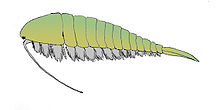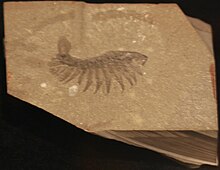Alalcomeneaus
|
Alalcomenaeus Temporal range: Cambrian Stage 3–Mid Cambrian |
|
|---|---|
 |
|
 |
|
| Specimen of Alalcomenaeus cambricus on display at the Royal Ontario Museum, Toronto | |
| Scientific classification | |
| Kingdom: | Animalia |
| Phylum: | Arthropoda |
| Class: | †Megacheira |
| Family: |
†Alalcomeneidae Simonetta 1970 |
| Genus: | †Alalcomenaeus |
| Species: | †A. cambricus |
| Binomial name | |
|
Alalcomenaeus cambricus Simonetta 1970 |
|
Alalcomenaeus is one of the most widespread and longest surviving arthropod genera of the Early and Middle Cambrian. Known from over 300 specimens in the Burgess shale, and the Chengjiang, it bears great similarity to the opabiniids.
Alalcomenaeus had three median eyes; two stalked, more lateral eyes; a triflagellate great appendage; and two more head appendages posterior to that. Like its body appendages, these were biramous — their inner branch was spiny, segmented, flexible and leg-like, while the outer portion had a large surface area and resembled a flap.
Alalcomenaeus reached about 6 cm in length, although many smaller specimens are known. Its head was covered with a shield, and its eleven body segments were also covered with an exoskeleton. Its body terminated with a paddle-like telson ("tail") which probably helped to propel the organism; this ended with long flat spikes in the plane of the tail fin.
The organism probably swam, wafting its outer flap-limbs in waves along its body to gain propulsion, in the manner of Anomalocaris. Its inner limb branches do not appear to be optimised for walking, although it is possible they helped the organism move along the sea floor. A variety of other functions have been suggested, such as clinging to algal fronds; they seem best suited to grabbing onto, and tearing up, other animals, suggesting that the organism was probably a scavenger. However its large eyes and the long flagella on its great appendages, combined with its large feeding apparatus and the spines on its inner limb branches, are more consistent with a predatory lifestyle, and the most recent interpretation has it feeding on organisms that lived on or in the surface of the sea floor.
Alalcomenaeus was initially thought to fall in the stem group to the crustacea, and was placed in a clade with Leanchoilia, Actaeus and Yohoia. It has more recently been placed with the Opabiniids, mainly on the basis of its great appendage. More up to date analyses place it along with Leanchoilia and Yohoia as well as Sanctacaris, Habelia, Sarotrocercus and Sidneyia, somewhere within the arachnomorpha. The closeness of Sanctacaris and Leanchoilia has been supported by subsequent work, and Actaeus is often excluded from such works as it is poorly understood. The recently described Dicranocaris appears to be very closely related indeed to Alalcomenaeus.
...
Wikipedia
